 Image search results - "school" Image search results - "school" |

No. 4 elementary school (Dai-yon Shogakko) where you get off the bus and where the Information Center is. 第四小学校
|
|
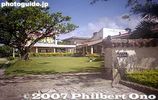
Taketomi Primary School
|
|
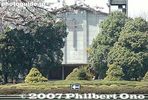
International Christian University is one of Japan's leading English-speaking universities.
|
|

The middle of the campus has a long, straight road lined with cherries.
|
|

It's peaceful and quiet, and the cherries are stunningly beautiful when in full bloom.
|
|

Cherry blossoms tunnel
|
|
|
|
|
|

Sakura tunnel
|
|
|
|
|
|
|
|
|
|
|

Cherry bicycles
|
|
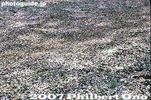
Don't forget to shoot the petals.
|
|

Petals
|
|

Staged shot
|
|

On Aug. 8, 2007, I was allowed to join the Imazu Jr. High School Rowing Club as they rowed from Nagahama to Imazu. Photo: A briefing by the club's coach before departure in front of a minshuku lodge near Nagahama Castle.
|
|
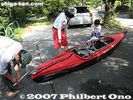
This "Biwako shuko" (Rowing around Lake Biwa) between Imazu and Nagahama was the club's annual summer tradition since 1995. Photo: Assembling a two-man kayak.
|
|

On the day before, they were supposed to row from Imazu to Nagahama, but high waves forced cancellation. So they were bused to Nagahama where they stayed overnight. Photo: Carrying the kayak to the lake, passing by Nagahama Castle.
|
|
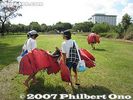
Almost 50 members in the club, and almost all of them participated in this rowing trip. Some of them did this for the third time. Photo: Carrying life vests. All rowers are required to wear life vests.
|
|
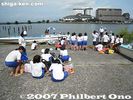
In the morning, two fishing boats pulled the rowing boats from Imazu to Nagahama Port where we met them here. 今津中学校ボート部の琵琶湖周航
|
|
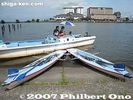
They used five boats to row, including these two ocean scull boats.
|
|

Two fixed-seat boats were also used.
|
|

And girls on the other fixed-seat boat. These boats have fixed seats which do not slide as in modern rowing boats. This boat is a replica of the fixed-seat boat used 90 years ago by Oguchi Taro and crew when he wrote the song, Biwako Shuko no Uta.
|
|

I wanted to experience rowing this fixed-seat boat on Lake Biwa, and rowed with these jr. high girls from Nagahama Port. 千秋・太郎号のフィックス艇
|
|

"We're children of the lake, off to wander 'round..." (Mt. Ibuki in the distance)「われは湖の子...」
|
|

"This journey fills my heart with intense happiness..."「さすらいの 旅にしあれば しみじみと」
|
|
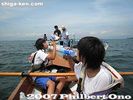
Yes, replenishing your fluids is important...
|
|
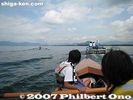
We were far behind, so a support boat pulled us along. Two fishing boats provided support for the rowing trip.
|
|
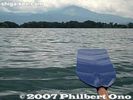
"Hira and Ibuki too, only but a dream"
|
|
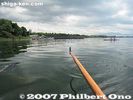
After about an hour, our first on-shore break, nears Sports no Mori in northern Nagahama.
|
|
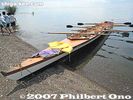
Our fixed-seat boat 千秋・太郎号のフィックス艇
|
|
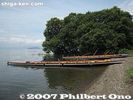
Twin fixed-seat boats. One is named "Chiaki/Taro" and the other is called "Yodo," after Yodogawa River in Osaka. Lake Biwa's water feeds Yodogawa River.
|
|
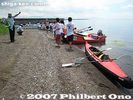
Rowers changed boats. Those without a rowing boat were transported on the fishing boats.
|
|
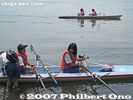
Ocean scull
|
|
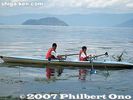
Chikubushima and ocean scull
|
|
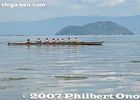
Chikubushima and fixed-seat boat
|
|
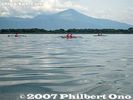
Three ocean sculls wander in front of Mt. Ibuki
|
|
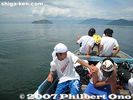
Chugging along on a fishing boat.
|
|
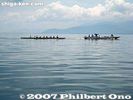
Getting a free ride were these girls heading for Sugaura, a small town on the northern shore of Lake Biwa.
|
|
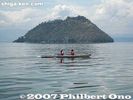
Ocean scull rowers and a sickly Chikubushima going bald. The numerous cormorants are killing off the trees on the island.
|
|
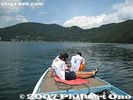
Heading toward Sugaura, Nishi-Azai in northern Lake Biwa.
|
|

Approaching Sugaura
|
|
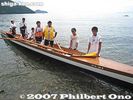
Boys posing for a picture at Sugaura
|
|
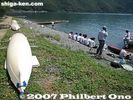
Lunch break at Sugaura, a scenic lakeside town. It is also where the scenic Oku Biwako Parkway road starts.
|
|
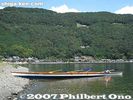
Fixed-seat boat フィックス艇
|
|
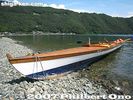
I love the design of this boat. 千秋・太郎号のフィックス艇
|
|
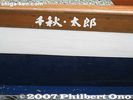
This boat's name is "Chiaki/Taro," named after the writer (Oguchi Taro) and composer (Yoshida Chiaki) of the song, Biwako SHuko no Uta.
|
|
|
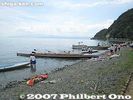
Sugaura
|
|
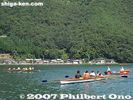
Departing Sugaura
|
|
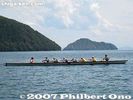
Departing Sugaura with Chikubushima in the background.
|
|
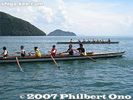
Fixed-seat boats
|
|
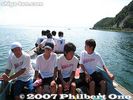
Fishing boat for human transport. It was a very hot day with no wind.
|
|
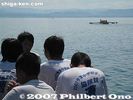
Boys watch their classmates row.
|
|

Rowing away from Sugaura
|
|
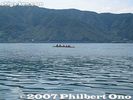
"With our sights set nowhere, rolling with the waves..."「ゆくえ定めぬ、波枕」
|
|

Off Makino Sunny Beach
|
|
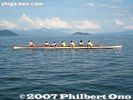
Fixed-seat boat with Mt. Ibuki and Chikubushima in the background. 千秋・太郎号のフィックス艇
|
|
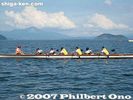
"Today is Imazu or, Nagahama huh..."「今日は今津か 長浜か」
|
|
|
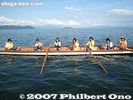
All-girl crew pose for a picture. The rowing club has more girls than boys. はい、ポーズ!
|
|
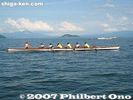
Sleek boat slicing through the water.
|
|

They refused to be pulled by the fishing boat. They wanted to row all the way home to Imazu.
|
|
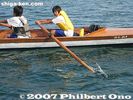
Catch, row, catch, row...
|
|
|
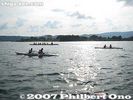
Fixed-seat boats and ocean sculls rendezvous toward home in Imazu.
|
|
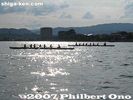
Target destination in sight
|
|
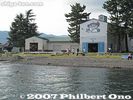
Imazu boathouse
|
|
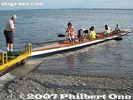
Bringing the boat to dock.
|
|
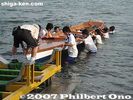
The boat is first carried onto a trolley.
|
|
|
|
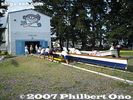
Hauling the fixed-seat boat to the boat house
|
|
|
|
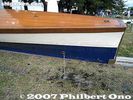
Water drain
|
|

Fixed seat
|
|

Oarlock on fixed-seat boat
|
|
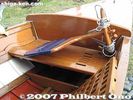
Cox seat and rudder (removed). Beautiful boat, and I'm darn happy to have rowed on this rare boat. Felt almost like Oguchi Taro.
|
|

Inside the boat house
|
|

"Tell us my friends your stories, with your fervent hearts."「語れ我がが友 暑き心」 Also see my YouTube video here.
|
|
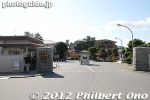
Entrance to the Naval Academy on Etajima.
|
|
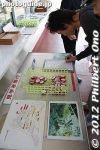
Reservations are not required, but you have to get there and sign up 5 min. before the 90-min. tour starts.
|
|

The Naval Academy conducts free guided tours of the school 3 or 4 times a day. The tour takes you around the campus and allows you to enter a few of the imposing buildings.
|
|

Map of the Naval Academy or Japanese Maritime Self Defense Force First Service School (海上自衛隊第1術科学校).
|
|
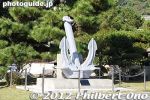
You cannot tour the Naval Academy on your own. You have to join the guided tour. There is a dress code: No miniskirts or provocative clothing by women.
|
|
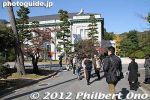
Two Naval Academy students served as our tour guide.
|
|
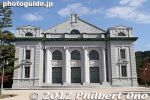
Ceremonial Hall. Built in 1917 and designed for holding ceremonies and moral education. One of the few buildings which we could enter. Etajima, Hiroshima.
|
|
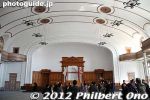
Inside the Ceremonial Hall. It can fit 2,000 people.
|
|
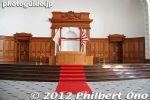
Stage inside the Ceremonial Hall.
|
|
|
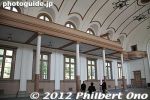
Ceremonial Hall
|
|
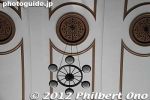
The lights look like a ship's wheel on the ceiling of the Ceremonial Hall.
|
|
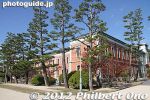
The academy's pine tree trunks grow straight up. They say that even the pine trees stand at attention at the school.
|
|
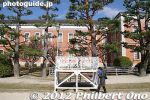
Stand for gatherings.
|
|
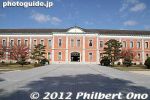
The academy's most distinctive building is this Students’ Hall dubbed the "Red Brick Building." We weren't allowed to go inside. Etajima, Hiroshima.
|
|
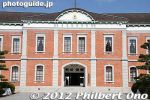
Built in 1893 and used for classrooms and living quarters for students. Today, it is part of the Officer Candidate School and used as classrooms and students' living quarters. Etajima, Hiroshima.
|
|
|
|
|
|
|
|
|
|
|
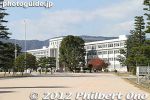
Students' Hall west wing. Built in 1938, it is used as the main students’ hall of the First Service School.
|
|

Students' Hall west wing. We weren't allowed to enter this building. The Academy also has female students, but after graduating they do not serve on navy ships. They work only on land.
|
|
|
|
|
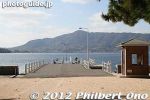
Front Pier. This is considered the school's front gate instead of the gate on land. Officer Candidate School graduates are sent off here by school staff and a military band and transferred to a training fleet anchored offshore in Etauchi inlet.
|
|
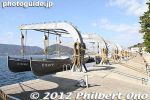
Training boats
|
|
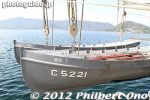
Training boats
|
|
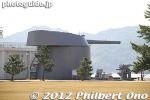
Battleship gun, life-size.
|
|
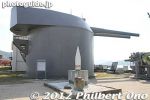
The Gun turret was a part of the main gunnery system of Battleship Mutsu and was transferred to Imperial Naval Academy for use as a study aide in 1935.
|
|
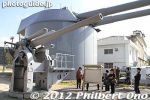
Gun turrets
|
|
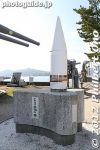
Projectile of a "Mutsu" class battleship.
|
|
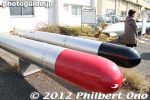
Torpedoes
|
|
|
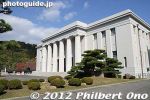
Naval History Museum on Etajima. Built in 1936, the museum is substantial with detailed exhibits tracing Japan's naval history (including the Pearl Harbor attack).
|
|
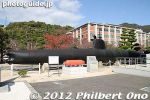
The Naval History Museum on Etajima has this outdoor display of one of the five midget submarines used in the Pearl Harbor attack.
|
|
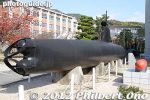
One of the five midget submarines used in the Pearl Harbor attack. On display at the Naval History Museum on Etajima island, Hiroshima.
|
|
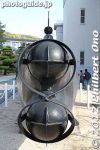
Torpedo bay of midget submarine used in Pearl Harbor attack.
|
|
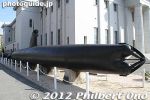
The midget sub displayed here was found in 1960 off Keehi Lagoon east of Pearl Harbor's entrance. The sub had been damaged by a depth charge attack and abandoned by its crew before it could fire its torpedoes.
|
|
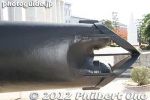
It was subsequently salvaged and restored for display at Etajima in 1962. The front part of the sub was severed, so the front part was reconstructed by a Kure shipbuilder for this display.
|
|
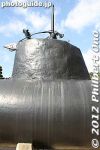
Midget sub's conning tower and periscope. The sub had only two crew members.
|
|
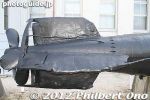
Midget sub's rudder and propeller.
|
|
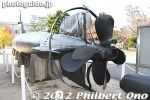
They eventually found all five subs (the fifth one was finally found in 2009) used at Pearl Harbor. Two of them are on display. One of them is here and the other is at the National Museum of the Pacific War in Fredericksburg, Texas.
|
|
|
|
|
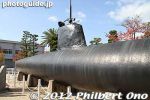
This midget sub was transported by boat from Pearl Harbor to Yokosuka (Kanagawa Pref.), then to Etajima in 1961.
|
|
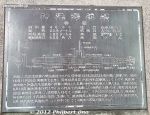
About this midget sub: Length: 23.9 meters, Weight: 46 tons, Inner diameter: 1.85 meter, Underwater speed: 19 knots (600 horsepower)
|
|
|
|
|
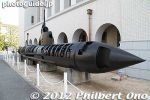
Behind the midget sub used in Pearl Harbor, another different type of midget sub is displayed.
|
|
|
|
|
|
|
|
|
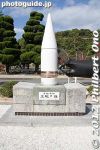
A projectile used by battleship Yamato during WWⅡ.
|
|
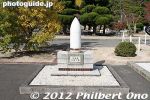
Projectile used in Japan-China War in 1894.
|
|
|
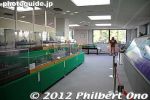
Last stop on the tour was the Etajima Club where there is a gift shop, restaurant, and this small museum on the 2nd floor.
|
|
|
|
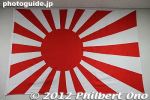
Japanese navy rising sun flag
|
|
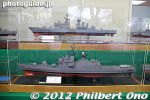
Models of navy warships.
|
|
|
|
|
|
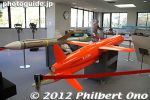
Etajima Club exhibition room.
|
|

Hachiman Primary School 近江八幡市立八幡小学校
|
|

Hachiman Primary School 近江八幡市立八幡小学校
|
|

Imazu Junior High School students
|
|
|

Imazu Junior High School students start the race.
|
|
|
|
|

Imazu Junior High School female students rowing in the 3rd Imazu Regatta.
|
|
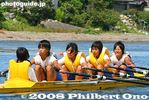
Imazu Junior High School female students rowing in the 3rd Imazu Regatta. Also see my YouTube video here.
|
|
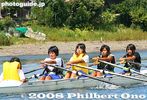
Imazu Junior High School female students rowing in the 3rd Imazu Regatta.
|
|

Imazu Junior High School female students rowing in the 3rd Imazu Regatta.
|
|
|
|
|
|

Near the finish line.
|
|
|

Finish line.
|
|

Imazu Junior High School Rowing Club banner and members going to the regatta's awards ceremony.
|
|

During Aug. 2008, the Imazu Junior High School Rowing Club also held a photo exhibition of their rowing trip across Lake Biwa held in Aug. 2007.
|
|

The photo exhibition was held at the Biwako Shuko no Uta Shiryokan museum. Many of the photos were also contributed by Philbert Ono.
|
|
|
|
|
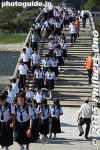
Kintaikyo is a popular destination for school trips. Kids snake over the arch bridges.
|
|
|

Near the Toya Mizunoeki is Toya High School whose Environment Club regularly take water samples from Lake Toya to test the lake's water quality. They go behind the Toya Mozunoeki and take water samples with plastic buckets.
|
|

The students do various tests, each one does a specific task. 洞爺高等学校
|
|

With buckets and water testing kits, they do their testing.
|
|

One girl takes notes as the others give her their test results.
|
|

Color charts are used to assess the water quality. This is for phosphoric acid.
|
|

For nitrate.
|
|

For Chemical Oxygen Demand (COD).
|
|

After the water testing is done, they throw back the water into the lake.
|
|
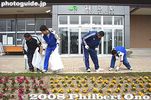
Local students from Abuta High School help beautify Toya Station.
|
|
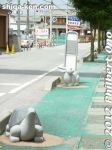
From Toyosato Station to Toyosato Elementary School, statues of a tortoise and hare adorn the sidewalk.
|
|

Designed by William Merrell Vories, the old Toyosato Elementary School building was built in 1937. This picture was taken in 2007, before renovations. This is the front gate.
|
|

Toyosato Elementary School after renovations in 2009. Nice new coat of paint makes the old school look almost brand new. MAP
|
|

Toyosato Elementary School before renovations. During 1999-2002, Toyosato gained national attention when this old elementary school building was going to be torn down by the mayor in opposition to activists who wanted to preserve the building.
|
|

Toyosato Elementary School after renovations. At a total cost of 650 million yen, the old building was repainted, reinforced against earthquakes, installed with an elevator, and preserved as much as possible.
|
|

Toyosato Elementary School before renovations.
|
|

Toyosato Elementary School after renovations. A ceremony was held on May 30, 2009 to mark the completion of the renovations.
|
|

Anyone can now enter this old building and look around. Free admission. The school is Toyosato's symbol.
|
|

Toyosato Elementary School name plate at the front gate.
|
|
|
|

Weather vane on top of the main building.
|
|

Statue of Furukawa Tetsujiro, the man who donated his own money to build the school in 1937. He donated 600,000 yen which is equivalent to today's value of a few billion yen.
|
|
|
|
|
|
|

Entrance hall. You have to take off your shoes and wear house slippers.
|
|

Little statue in the entrance hall.
|
|
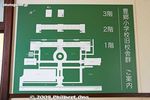
Map of the old school. The first floor has a public library, exhibition room, children's playroom, meeting rooms, and local board of education office.
|
|

First-floor corridor.
|
|

This exhibition room is what you first see when you enter the front entrance.
|
|

On display are old photos of the school.
|
|
|

Telephone booth
|
|

Old telephone
|
|

Scale model of old school.
|
|

Exhibition panels explaining school's history.
|
|

Old camera that was used to take the school pictures on display.
|
|

First floor corridor and stairway. Notice the rabbit sculpture.
|
|

Rabbit sculpture on the railing.
|
|

This rabbit sculpture and turtle sculpture represents the famous Aesop's fable, the race between the turtle and hare.
|
|
|
|

The turtle makes it way at its own, slow pace.
|
|

As the rabbit sleeps.
|
|

Second-floor corridor
|
|

VIP room.
|
|

VIP room.
|
|

Children's playroom
|
|

2nd floor corridor
|
|

On the 2nd floor, this classroom has been reconstructed.
|
|
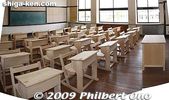
On the 2nd floor, this classroom has been reconstructed to look like what it was before.
|
|

This is one of two rooms in the building which has been reconstructed as a classroom for display purposes.
|
|

This is one of two rooms in the building which has been reconstructed as a classroom for display purposes.
|
|
|
|

Classroom door
|
|

Classroom windows as seen from the outside.
|
|

2nd floor corridor
|
|

On the second floor, a mural depicting a train station.
|
|

Another reconstructed classroom on the 2nd floor. This one was for homemaking.
|
|

End stairway with wash basin.
|
|
|
|
|

Stairway
|
|

Stairway with turtle statue on railing.
|
|

Cubby hole
|
|

Looking toward the school auditorium.
|
|

School auditorium.
|
|

School auditorium.
|
|

School auditorium entrance.
|
|

Inside school auditorium.
|
|

Inside school auditorium.
|
|

The school auditorium also has an upper level.
|
|

View from the podium in the school auditorium. It looks like that they still use this auditorium.
|
|
|
|